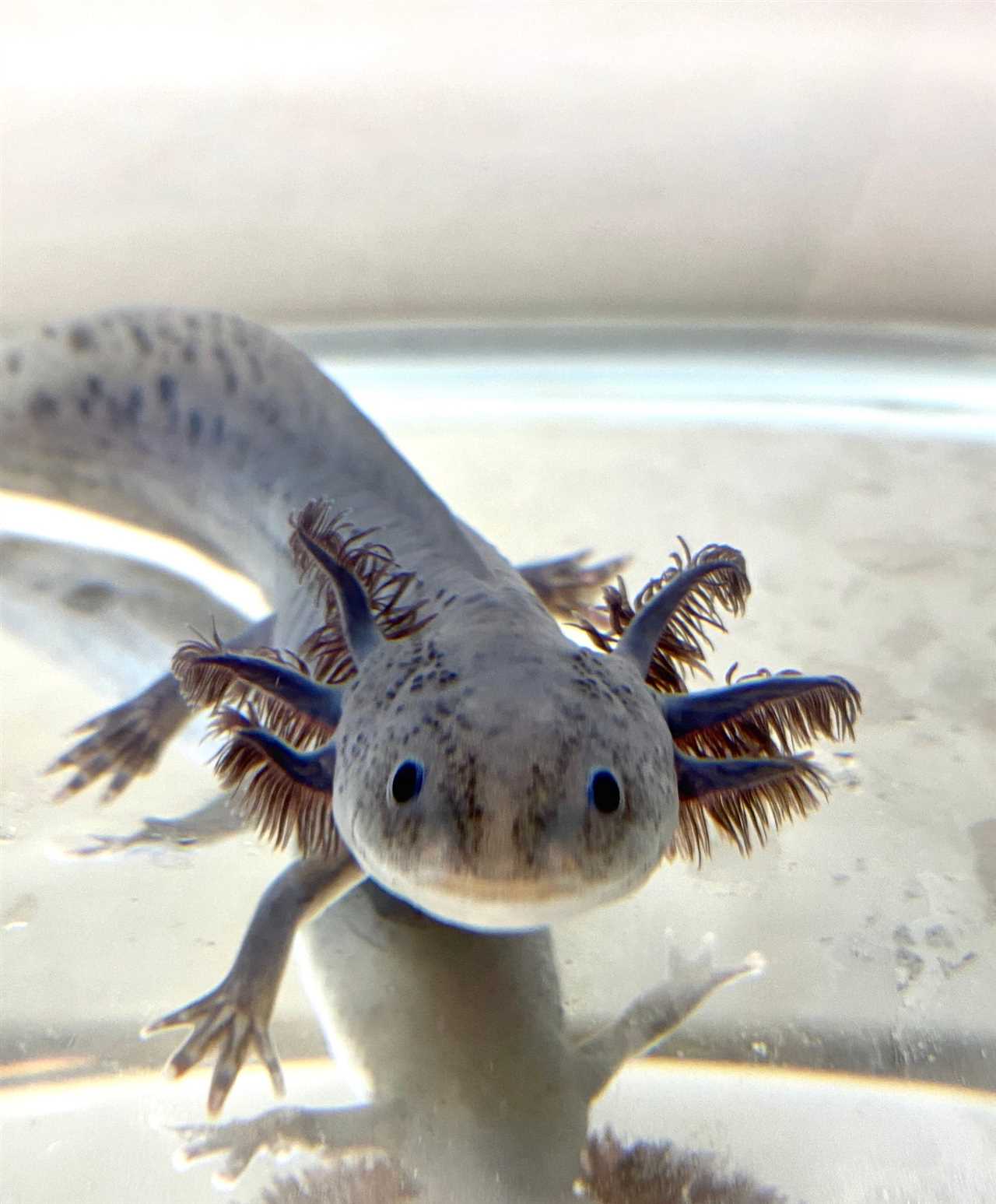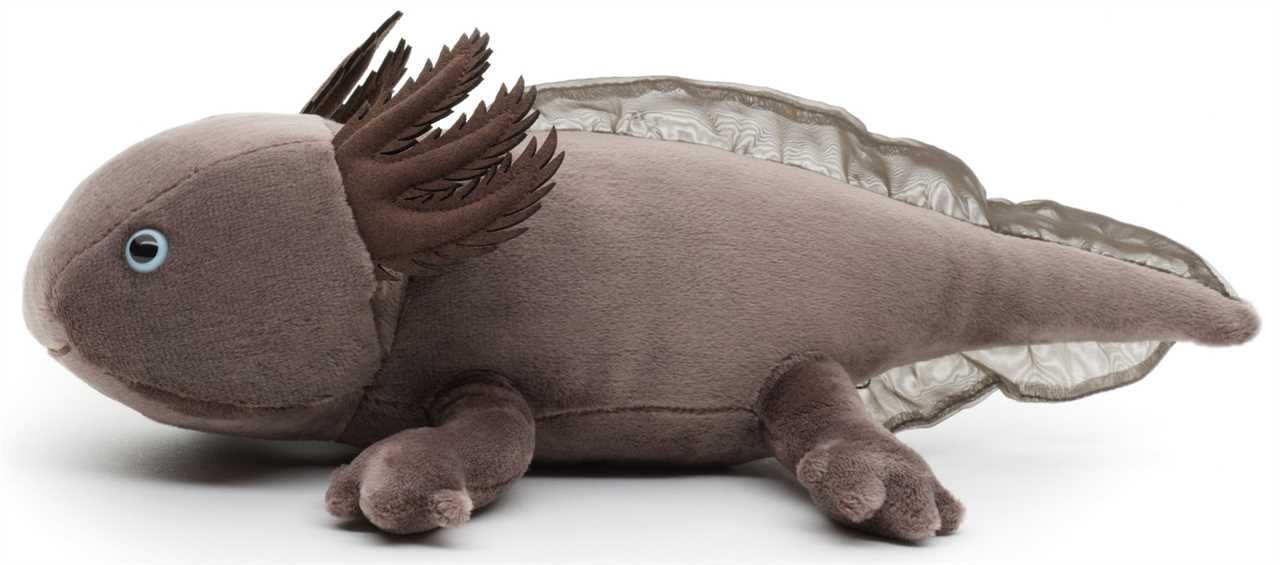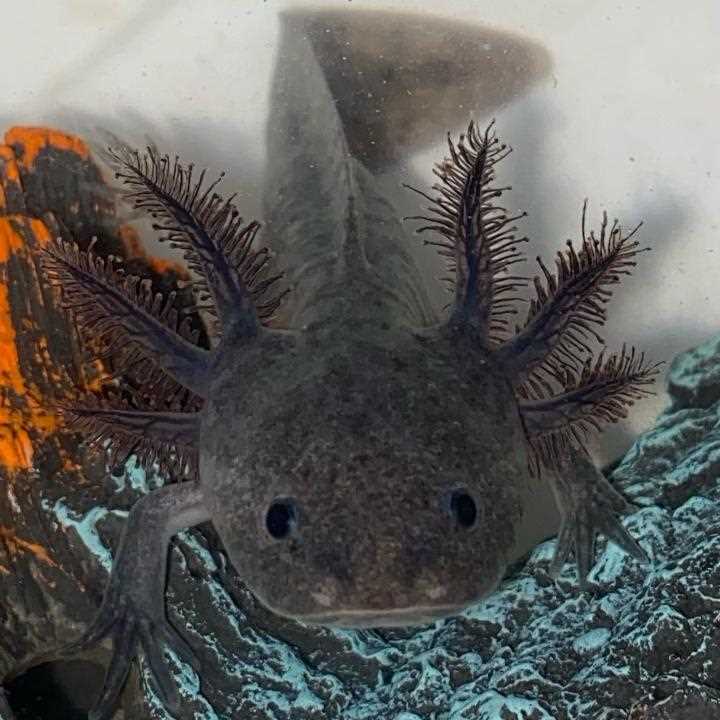Native to the ancient lakes of Mexico, particularly Lake Xochimilco and Lake Chalco, the grey axolotl has become an icon of the region’s rich biodiversity. However, due to habitat destruction and pollution, these lakes have been greatly diminished, putting the survival of this enigmatic species at risk. Efforts are now being made to conserve their natural habitat and protect the grey axolotl from further decline.
The Grey Axolotl: A Rare and Mysterious Mexican Salamander
Appearance and Characteristics
The grey axolotl is known for its unique appearance and characteristics. It has a long and slender body, with four limbs and fringed gills on the sides of its head. It has a smooth, slimy skin that can range in color from pale grey to dark grey, with some individuals having spots or specks of black. Its eyes are small and black, and it has a wide mouth with tiny teeth.
One of the most interesting features of the grey axolotl is its ability to regenerate lost body parts. Unlike other salamanders, the axolotl can regrow not only its limbs, but also its spinal cord, heart, and other organs. This remarkable regenerative ability has made it a subject of extensive scientific research.
Habitat and Behavior
The grey axolotl is predominantly aquatic and can be found in the shallow waters of lakes, ponds, and canals. It prefers a habitat with dense vegetation, where it can hide and find food. It is a nocturnal creature and is most active during the night.
Conservation Status
The grey axolotl is listed as critically endangered by the International Union for Conservation of Nature (IUCN). Its population has declined significantly due to habitat destruction and pollution of its natural environment. The Xochimilco canals, which are its primary habitat, are under threat from urbanization and agricultural practices.
Efforts are underway to protect and conserve the grey axolotl. Conservation organizations are working to raise awareness about the species and its importance in maintaining a healthy ecosystem. Captive breeding programs have been established to ensure the survival of the species in case of further decline in the wild.
Habitat and Distribution
The axolotl is a neotenic species, which means that it retains its larval characteristics throughout its entire life. This is why it has remained in its aquatic form and never undergoes metamorphosis into a terrestrial adult like other amphibians. Its aquatic habitat is crucial for its survival as it relies on the water to breathe and move around.
Habitat Features
The axolotl’s habitat is characterized by a combination of vegetation, sandy bottoms, and submerged logs and rocks. These features provide the axolotl with food, shelter, and places to hide from predators. The vegetation also helps to maintain the water quality by filtering pollutants and providing oxygen.
The water in the axolotl’s habitat is typically shallow and has a relatively high temperature, ranging from 16 to 18 degrees Celsius. This temperature range is optimal for the axolotl’s metabolism and allows for its unique respiratory system to function properly.
Distribution
Efforts are being made to protect and restore the axolotl’s habitat, as well as to implement conservation programs to increase its population. However, the axolotl is still considered critically endangered, and its future survival depends on continued conservation efforts and the reduction of pollution in its habitat.
| Common Name | Scientific Name |
|---|---|
| Axolotl | Ambystoma mexicanum |
Physical Characteristics of the Grey Axolotl

The grey axolotl is a unique and fascinating creature with distinct physical characteristics. These features set it apart from other salamanders and make it a beloved species among enthusiasts and scientists alike.
One of the most striking characteristics of the grey axolotl is its external gills. Unlike other amphibians, the axolotl retains its gills into adulthood. These feathery gills extend from the sides of its head and serve as its primary means of respiration. The gills are highly efficient and allow the axolotl to extract oxygen from water, making it a proficient aquatic animal.
In addition to its unique gills, the axolotl also possesses four legs with delicate webbing between the digits. These limbs allow the axolotl to navigate its aquatic habitat with ease. The webbing provides stability and helps in propelling the axolotl through the water, enabling it to catch prey and escape from predators.
In terms of color, the grey axolotl exhibits a range of shades, including light grey, dark grey, and even black. The coloration can vary depending on factors such as age, genetics, and environment. Some individuals may also have speckles or patches of other colors on their bodies, adding to their diversity and beauty.
The grey axolotl’s body shape is elongated and slender, with a flat head and a wide mouth. Its eyes are small and lidless, giving it a unique appearance. These eyes are adept at detecting movement and help the axolotl locate prey in its surroundings.
Overall, the physical characteristics of the grey axolotl make it a captivating and extraordinary creature. Its external gills, webbed limbs, neotenic features, coloration, and body shape contribute to its distinctive allure and contribute to its status as an iconic Mexican salamander.
Axolotl: Life Cycle and Reproduction

The incubation period for axolotl eggs is around 10 to 14 days, depending on water temperature. After this period, small larvae hatch from the eggs. These larvae are equipped with external gills and a fin-like tail. They rely on their gills for respiration and move around the water using their tails.
Despite their unusual life cycle, axolotls are still capable of reproducing and maintaining their population. However, they face numerous threats in the wild, such as habitat loss and pollution. Conservation efforts are crucial to ensure the continued survival of these fascinating and mysterious creatures.
Conservation Status
The grey axolotl is currently classified as critically endangered by the International Union for Conservation of Nature (IUCN). This means that the species is facing an extremely high risk of extinction in the wild. The main threats to the grey axolotl’s survival include habitat destruction, water pollution, and the introduction of non-native species.
Habitat destruction is a major concern for the grey axolotl because its natural habitat, the Xochimilco wetlands in Mexico City, is rapidly shrinking. The wetlands have been drained and converted into agricultural land and urban areas, leaving the axolotl with very limited space to live and breed.
Water pollution is another significant threat to the grey axolotl. The Xochimilco wetlands have been highly polluted by industrial and agricultural activities, as well as by untreated sewage and trash. The polluted water reduces the axolotl’s ability to find food and can also lead to health issues and reproductive problems.
Efforts are being made to conserve the grey axolotl and its habitat. Conservation organizations are working to restore and protect the Xochimilco wetlands, including by implementing measures to reduce pollution and restore water quality. Captive breeding programs have also been established to breed and release grey axolotls back into the wild.
Education and raising awareness about the grey axolotl and its conservation needs are important tools in the effort to save the species. By informing people about the importance of the grey axolotl and its role in the ecosystem, conservationists hope to gain support for conservation initiatives and encourage sustainable practices that will benefit both the axolotl and its habitat.
Cultural Significance of the Axolotl

The axolotl holds great cultural significance in Mexico and has been an important symbol in Mexican art, literature, and mythology for centuries. It is considered a sacred animal by the indigenous peoples of Mexico, particularly the Aztecs. They believed that the axolotl possessed divine qualities and was a messenger between the earthly world and the spiritual realm.
In Aztec mythology, the axolotl was associated with the god Xolotl, who was responsible for guiding the souls of the dead into the afterlife. It was believed that when a person died, their soul would transform into an axolotl before journeying to the underworld.
The axolotl’s unique ability to regenerate its limbs and organs also contributed to its cultural significance. The Aztecs admired this extraordinary regenerative power and associated it with rebirth and renewal. They saw the axolotl as a symbol of resilience, adaptability, and the cycle of life.
Furthermore, the axolotl’s distinctive appearance and otherworldly qualities have captured the imagination of artists and writers throughout history. It has been depicted in ancient Mexican manuscripts, murals, and pottery, as well as contemporary paintings, sculptures, and tattoos. The axolotl’s enigmatic nature continues to inspire creativity and curiosity among people from all walks of life.
In recent years, the axolotl has also gained popularity as a beloved pet and aquarium species. Its unique features and docile temperament make it a fascinating and easy-to-care-for addition to home aquariums. The axolotl’s popularity as a pet has helped raise awareness about the species and the need for its conservation.
Despite its cultural significance and popularity, the axolotl faces numerous threats, including habitat loss, pollution, and illegal wildlife trade. Conservation efforts are underway to protect the species and ensure its survival in the wild. These initiatives include habitat restoration, captive breeding programs, and educational campaigns to raise awareness about the importance of preserving this unique and iconic Mexican salamander.

I’m Lena Adams—a product of an unconventional upbringing in the African wilderness. My father, a daring explorer of African wildlife, sparked my fascination with reptiles, a passion that intertwined with the tragic loss of my mother during an expedition, leaving an indelible mark on my life. Driven to understand the creatures that captivated my parents, I embarked on my journey, sharing insights about reptiles, frogs, and lizards on my website. Through my explorations and conservation efforts, I honour my family’s legacy while seeking connections—to the creatures, nature, and the mother whose presence I yearn to understand.
